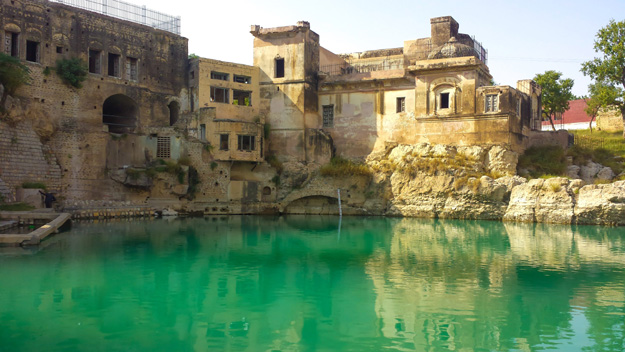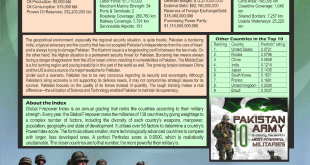 Cordial interreligion relations create strong ties
Cordial interreligion relations create strong ties
The contemporary world is in the throes of violence. All around the world, people are being killed, terrorized and threatened in the name of religion. The religious shysters and war-mongers have spread hatred to such an extent that even very roots of peace in society have been shaken. Sectarian violence and intolerance have also reached epidemic proportions. It is due to this fact that the very word “religion,” unfortunately, is now considered synonymous with terror and fear. In this dismal state of affairs, interfaith harmony is pressingly needed. Besides cultural, linguistic and racial diversity, Pakistan hosts a number of religions, with Islam – the religion of more than 90 percent of Pakistanis – Hinduism, Christianity and Sikhism being the prominent ones. But, despite the fact that these four major religions exist in the country, the notion known as ‘inter-religion dialogue’ in the community is almost non-existent. Every religion has its own flavour and values; no religion around the globe professes hate and discord.
“Just as a candle cannot burn without fire, men cannot live without a spiritual life.” (Buddha)
The term interfaith dialogue refers to compliant, productive and positive interactions between and among the peoples having different beliefs or religions at individual or institutional levels with an aim to bring peace, progressive change and harmony to the masses. Harmony gives one the right to live and let others live peacefully. It surely paves way or directs one towards peace and prosperity. In a changing world order, which is determined by competitive world politics and topsy-turvy economic conditions, promotion of interfaith harmony is inevitable.
Interfaith harmony is a condition which suggests a pacific coexistence of followers of various religious beliefs, with an objective to abolish violence. With a practical model of interfaith harmony, it proposes understanding of all religions and respecting everyone’s beliefs without disturbing the surroundings. All religions taught peace, love, tolerance and respect for humanity and stressed the need for dialogue among different religions and civilizations for promoting harmony and tranquility. To have harmony and peace, people should shun their differences and share their experiences.
A number of communities live in Pakistan and in spite of being an Islamic state, the country guarantees the provision of all basic human rights as well as civic freedom to its minorities. Flag of Pakistan is not complete without its white part, i.e. minorities. However, during the past few years, unfortunately, religious extremism, intolerance and terrorism have increased, and minorities, too, were not immune to its effects. Their places of worship were targeted to sow the seeds of discord and distrust among the followers of different faiths.
But, one thing that needs to be acknowledged here is that it is not a new phenomenon; men have been suffering throughout history from lack of toleration for others’ beliefs. With the cry “Deus Vult!” (God wills it), rivers of blood have flowed as a result of religious intolerance. Crusades, Inquisition, Holocaust at Auschwitz, are but some examples. Moreover, activities of Holy Offices, which were established by the papacy in the Middle Ages, for seeking out, trying and sentencing persons of heresy, as well as brutal massacres and inhumane torture of Hispanics and of Albigensian of southern France, leave the man of our age with no doubt that intolerance is destructive. Thus, for all of us to survive on this planet, respecting religious beliefs of others and learning how to have a peaceful and harmonious religious coexistence under the principle of ‘the right to believe as one chooses’ is inevitable.
The founder of Pakistan, Quaid-i-Azam Muhammad Ali Jinnah, clearly said about the rights of minorities in Pakistan: “The minorities to whichever community they may belong, will be safeguarded. Their religion, or their faith or their belief will be protected in every way possible. Their life and property will be secure. There will be no interference of any kind with their freedom of worship. They will have their protection with regard to their religion, their faith, their life, their property, their culture. They will be in all respects citizens of Pakistan without any distinction of caste or colour, religion or creed. They will have their rights and privileges and no doubt, along with it goes the obligation of citizenship.”
In Pakistan, there are numerous landmark religious places belonging in different religions. Pakistan is home to Sikhism’s most important sites of worship. Nankana Sahib, a city near Lahore that is the birthplace of the very first Guru of Sikhs, Guru Nanak, after whose named this has been named; and Gurdwara Janam Asthan, was built in 1600 CE by the parents of Guru Nanak, making it not only a place of worship but also an epitome of rich history.
In addition, Gurdwara Dera Sahib, Lahore, was built upon the place where Guru Arjun Dev Ji who lost his life in the River Ravi in 1606 AD. It was here that late Mahraja Ranjit Singh built a small Gurdwara which was later reformed in 1934AD.
Kartarpur Sahib is the only Gurudwara in Pakistan in which Muslims are allowed to enter. The place holds special significance for Sikhs because their founder, Guru Nanak, lived the last 18 years of his life there. It is also the place where the Sikh community’s second Guru, Bhai Lehna, later named Angad, hailed from. It is located on the banks of river Ravi, Kartarpur has no habitation around it.
Religious place of Hinduism Panchmukhi Hanuman Mandir is one of the oldest temples of Karachi and is about 1500 years old. This temple is unique as it is the only temple in the world that contains an original statue of the Hindu god ‘Hanuman’, being in a natural state. Therefore, this temple holds great significance to Hindus all over the world, giving the Pakistani Hindus another reason to be proud of their heritage.
Katasraj Temple is another important site for Hindus. It has a deity of Lord Shiva and legend has it that the clear mystical pond that lies between the temples is the tears of “Shiv” he shed upon losing “Sita”. The temple has been there since Mahabharata and the holy place that comprises ‘Satgraha’ – seven seats of distinct deities – in its very premises. It has become a popular sight not only for tourists, but also for Hindus who come here to worship.
Hinglaj Mata Temple, Balochistan has the historical importance that Sati’s father, Pajapati Daksh, was against the marriage of Shiva and Sati. As the legends goes by since Sati was not invited to a ‘yajna’ that her father hosted, she jumped, in an act of defiance, into the fire and committed suicide. However, her body did not burn and Shiva searched the world with her corpse and upon finding Vishnu, her body was dismembered into 52 pieces out of which, it is said that her head fell at this ‘Shakti Peeth’ which is now known as Hinglaj Mandir. This Mandir holds great significance to Hindus from all parts of the world.
Katasraj Temple also has the remains of a Buddhist Stupa.
The Holy Trinity Cathedral, near Zainab Market in Karachi, is the seat of the Church of Pakistan. This 18th-century church has beautiful carvings on its arches and traditional stained glass on windows, representing the Prophet Jesus (RA) and his mother Mary .
Christ Church in Rawalpindi is one of the churches that have commemorative plaques in its interior for those who laid their lives during action. The architecture of the church is quite similar to those of various Western cultures. Every Sunday, it holds the traditional mass and the Christian community has made a valiant effort at maintaining the Christ Church beautifully.
St. Patrick’s Cathedral in Karachi is 120 years old and is built in Gothic revival architecture. In 1978, when the Cathedral celebrated its centenary, Pope John Paul-I sent his blessings and warm wishes after which in 1991 the iconic Mother Teresa visited the esteemed Cathedral as well.
Sacred Heart Cathedral, Lahore, was consecrated in 1907 by the Bishop of Lahore and is a sight worth seeing. It is one of the most important Catholic churches of Lahore and once you step inside the premises, the breathtaking architecture takes you back in time and stands as a hallmark for cultural solidarity.
Pakistan, being an Islamic Republic, does not mean that it is only for Muslims. It gives all rights and privileges to different sects living here though propaganda is always on to malign and defame the country. The interfaith harmony and peace-building aim to foster religious and social harmony and help develop a diverse society in Pakistan in which people of different beliefs can live together in peace and exercise their basic human rights. Interfaith dialogue, peace-building skills and participating in different events of other religions can not only help in promoting tolerance and respecting each other’s faith but definitely it will give insights and help in building positive image of Pakistan. It is the need of the time to develop and identify psychic understandings around the true moderate and tolerant message of Islam to be able to emerge as a meaningful voice in the inter-faith as well as intra-faith dialogue.
 Jahangir's World Times First Comprehensive Magazine for students/teachers of competitive exams and general readers as well.
Jahangir's World Times First Comprehensive Magazine for students/teachers of competitive exams and general readers as well.


